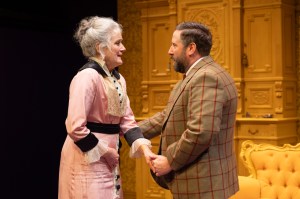Jo Caird: Theatre and Dining – More Than Just a Matter of Taste
For the majority of theatre experiences, audience
members are expected to sit quietly in a seat in an auditorium and watch and
listen intently to action taking place on a stage in front of them. With
immersive theatre, of course, the rules are a bit different: audience members
are often free to move around an unconventional theatre space, engage with the
characters and take some part in the action of the drama. The downside of this
style of work, compared to traditional theatre, is that audience members’
attention is necessarily divided by the different things taking place. If
handled badly, this can make for a potentially dissatisfying theatre experience
as audiences see a show piecemeal and get little sense of characters or
narrative. Done well, however, and what a company working this way loses in
narrative clarity, it gains in the intensity of experience available to
audiences who have much more at stake than with a traditional piece of work.
I got a strong sense of the precariousness of this balancing
act this weekend watching two pieces of work that each embrace the immersive in
a very visceral way: Dining With Alice is an Arts
Council-funded, Alice in Wonderland-inspired “theatrical
experience” involving dozens of community performers and taking place at Elsing
Hall in Norfolk as part of the Norfolk and Norwich Festival; Medieval
Banquet is a long-running commercial show featuring medieval music and
entertainment and catering largely to tourists; both involve a four-course meal
and immersive theatrical entertainment and both will set you back around £50 a
head.
I don’t want to get into a discussion of the different ways
that we treat supposedly ‘high’ or ‘low’ art – that’s a topic for another blog
all of its own – but I think it’s worth flagging up here that where
Dining With Alice has been reviewed by the nationals,
Medieval Banquet doesn’t even register on the theatre
community’s radar (and where it does, people tend to be sniffy about it), even though the two shows do essentially the same thing.
But back to the topic at hand – the challenge of making eating
part of a persuasive immersive theatre experience. Now, the food at
Dining With Alice is far better than that served at
Medieval Banquet (not really a surprise given that it was
designed by famed culinary wizards Bompass and Parr), and Dining With
Alice’s surroundings, the immaculate gardens of a moated 15th-century
manor house, are more impressive and atmospheric than Medieval
Banquet’s St. Katherine’s Dock space, but the two shows ultimately
suffer from the same problem: that the act of eating cannot help but distract
from the drama a company is attempting to create. However elaborate and appropriate
are the menu and the manner in which the food is served, it is hard to lose yourself in a piece
of theatre if you’re thinking about whether something tastes nice and
attempting not to drop food down your front.
If a company is intent on making a show involving eating,
therefore, there will inevitably be some sort of compromise when it comes to
the work’s theatrical element. Medieval Banquet handles this
by dividing its entertainment up into non-narrative segments that take place
between the courses of the meal. Each segment exists on its own and is about
instant gratification, whether that’s watching an acrobat do a gymnastics
routine or hearing Henry VIII sing “Greensleeves”. It’s simple and not
particularly challenging, but it works.
Where Dining With Alice falls down is
that it is based on a more complex concept involving characters from
Alice in Wonderland enacting snippets of relationships
during the meal itself that diners are able to see and hear depending on where
they are seated. I found the show’s immersive theatre element underwhelming
in terms of the way it was performed; greater attention had clearly been paid to the dining experience. By
marketing the show as a “magical theatrical experience” worthy of notice by the
national press, the company behind Dining With
Alice make promises that it is unable to deliver on.
Dining and theatre can go together, but this combination is only going to result in a satisfying entertainment experience for an audience if a company pays heed to the challenge of setting a show’s theatrical elements up in competition with as pedestrian and non-theatrical an act as eating.












